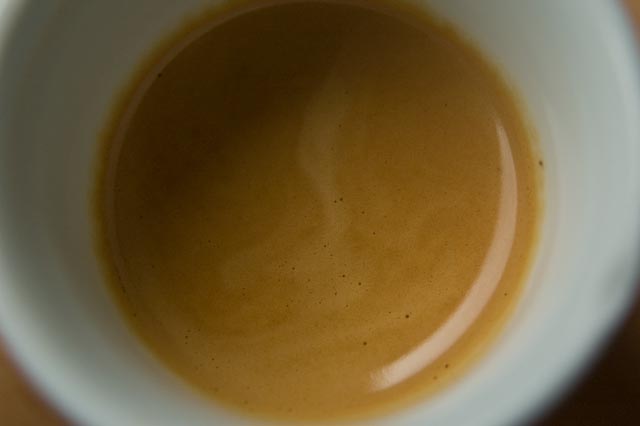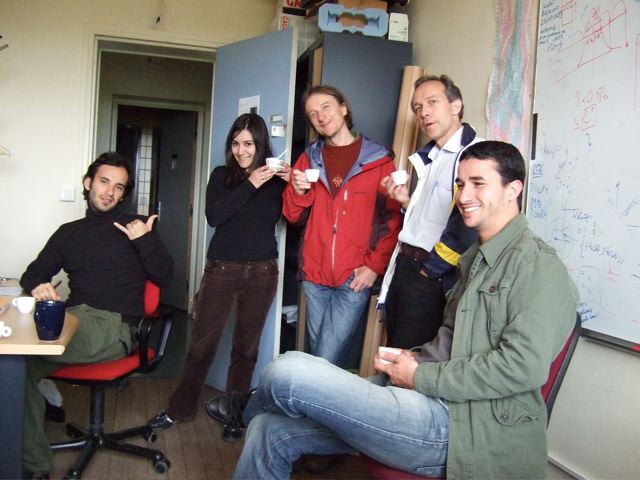Two years of blog posts and not a single one about astrophysics! But today, once again, I was interviewed by a journalist who wanted to know about dark matter. Wouldn’t we all! Around a year ago the maps of dark matter made by my collaborators in the
COSMOS project made the front page of Nature and as I was a co-author on the paper I got quite a few questions from curious journalists. I have a particularly fond memory of the intensive questioning I was given by Raphael Hittier of E-tele on the roof of the IAP building in the middle of a particularly cold Paris winter with a Siberian wind blasting across the terrace whilst Raphael asked me: “Qu’est-ce-que la matiere noir”? Ahhh…brr….
What indeed? I remember being astonished whilst I was a postdoctoral student in Durham to find out about the current orthodoxy, the Cold Dark Matter model (CDM for the initiated). And to learn that people had spent millions of hours of computer time on the world’s fastest computers making model universes filled with a mysterious substance whose exact properties were known very well (it’s a cold, dark, collisionless fluid which doesn’t interact with ordinary matter) — but whose precise nature was and still is a complete mystery. Okay, so we know what this stuff does — but what is it, anyway?
People have speculated that dark matter exists since at least the 1930’s when Fritz Zwicky realised that the rotation curves of galaxies could only be explained if there was a lot of matter in those galaxies which was not luminous. And in recent years gravitational lensing has given us spooky cosmic x-ray vision showing us where exactly the mass is, thanks to the deflection of light near gravitational sources. So maybe this stuff is really there.
As a graduate student, under the shadow of the cathedral in Durham, the mystery deepened even further. A lunch-time talk, I think it was, that wonderful Anglo-Saxon tradition (no-one would ever countenance such a thing in Italy or France, can you imagine working whilst eating?), rustling brown paper bags, crisp packets, coca-cola, and a presentation with a graph showing distance to supernovae plotted against the speed they were moving away from us. The “Hubble diagram”, named after mr. Edwin Hubble, who presented some of the first observational evidence that the Universe was expanding (which some of the theorists of the time actually expected). Every Hubble diagram I’d seen until then had showed a neat, linear relation between distance and velocity; the universe, the fabric of space and time itself, was expanding, and as a consequence more distant objects were moving away more rapidly. Except that in this Hubble diagram, there was something not right: some of the most very distant supernovae were just off the simple linear relation. Their error bars grazed the arrow-straight line of constant slope. But only a few of them.
It was an error, right? There was some mistake with the observations? Nobody wanted to believe that those outliers were real. It would meant that not only the Universe was expanding but also- gasp – accelerating. The cosy preferred model of the Universe that theorists had built up (which admittedly was looking a bit frayed for other reasons) would have to be discarded, radically revised, and someone would have to explain what exactly was pushing distant objects faster and faster apart, almost like a negative gravity.
But the outliers were real, and the Universe really is accelerating. The universe it seems is filled with some kind of invisible, dark energy, the exact nature of which is still unknown. It is this, somehow, which is accelerating the expansion of the Universe. Most of the mega-projects planned for astronomy in the next ten or twenty years will be devoted to finding out more about dark matter and dark energy, projects like LSST or Pann-starrs, which will map thousands of square degrees of sky to incredibly faint limits, making the most detailed maps of the universe, and hopefully ruling out some of the wackier models of dark energy.
But you do wonder, don’t you? I think of Mr. Ptolemy and his planetary epicycles, a complicated model which was replaced by something simpler and more universal (newtonian gravitation). The current cosmological model works really well — add in dark matter, dark energy turn the handle, and you can reproduce incredibly well all of the current cosmological observations to exquisite precision (modeling the formation of galaxies is another story). But the fact that almost all of the Universe (70% dark energy, 25% dark matter) consists of material of which we know almost nothing is more than a little unsettling — there may well be a hidden truth lurking in there, waiting to be discovered. A sign change that changes everything? An extra ingredient added to the model that makes 70% of the Universe suddenly become something else? We will find out soon enough, I hope.
Technorati Tags: Dark Energy, Dark Matter, cosmology




